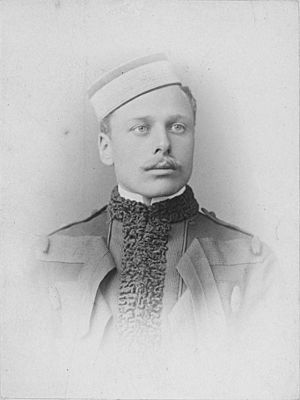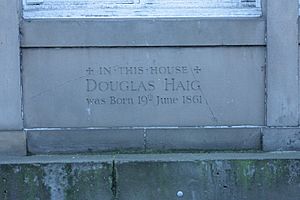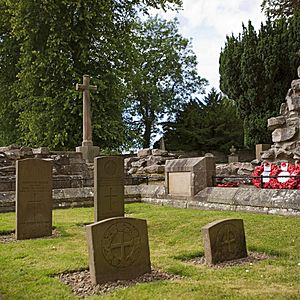Douglas Haig, 1st Earl Haig facts for kids
Quick facts for kids
The Earl Haig
|
|
|---|---|

Haig in 1917
|
|
| Nickname(s) | "Master of the Field" "The Butcher of the Somme" 'Butcher' Haig |
| Born | 19 June 1861 Charlotte Square, Edinburgh, Scotland |
| Died | 29 January 1928 (aged 66) 21 Prince's Gate, London, England |
| Allegiance | United Kingdom |
| Service/ |
British Army |
| Years of service | 1884–1920 |
| Rank | Field Marshal |
| Commands held | British Expeditionary Force (1915–19) First Army (1914–15) I Corps (1914) Aldershot Command (1912–14) Chief of the General Staff in India (1909–12) 17th Lancers (1901–03) 3rd Cavalry Brigade (1900) |
| Battles/wars | Mahdist War Second Boer War First World War |
| Awards | Knight of the Order of the Thistle Knight Grand Cross of the Order of the Bath Member of the Order of Merit Knight Grand Cross of the Royal Victorian Order Knight Commander of the Order of the Indian Empire Mentioned in Despatches Complete list |
Field Marshal Douglas Haig, 1st Earl Haig, was a very important officer in the British Army. He is famous for leading the British Expeditionary Force (BEF) during the First World War. He was in charge on the Western Front from late 1915 until the war ended.
He led British forces in major battles like the Battle of the Somme, the Battle of Arras, and the Third Battle of Ypres. He also played a key role in the final Hundred Days Offensive in 1918. This campaign helped lead to the end of the war. Some historians believe it was one of the greatest victories for a British-led army.
After the war, Haig was seen as a hero. His funeral was a day of national mourning. However, over time, his leadership during the First World War has been strongly criticised. He was even nicknamed "Butcher Haig" because so many British soldiers were killed or injured under his command.
Despite the criticism, some historians argue that Haig's leadership was important. They point out that his forces adopted new tactics and technologies. They also highlight the crucial role British forces played in the Allied victory in 1918. They suggest that the high number of casualties was a sad reality of warfare at that time.
Contents
Early Life and Army Career
Douglas Haig was born in Edinburgh, Scotland, in 1861. His father, John Richard Haig, owned a very successful whisky business. This meant the family had a lot of money.
Douglas went to several schools, including Clifton College. Both of his parents passed away by the time he was eighteen. After school, he studied at Brasenose College, Oxford. He was very good at horse riding and played for the university polo team.
Even though he went to university, he was older than most students when he joined the Royal Military College at Sandhurst in 1884. He did very well there, finishing first in his class. He became a lieutenant in the 7th (Queen's Own) Hussars in 1885.
Interesting Facts About Sir Douglas Haig
- Early in his army career, Haig played polo for England. He loved polo his whole life. He even became Chairman of the Hurlingham Polo Committee.
- He also served as President of the Army Polo Committee. He helped start the Indian Polo Association.
- Haig served in India starting in 1886. He was promoted to captain in 1891.
Family Life
Douglas Haig married Dorothy Maud Vivian in 1905. She had first seen him playing polo two years earlier. They had four children together:
- Lady Alexandra Henrietta Louisa Haig (born 1907)
- Lady Victoria Doris Rachel Haig (born 1908)
- George Alexander Eugene Douglas Haig, 2nd Earl Haig (born 1918)
- Lady Irene Violet Freesia Janet Augustia Haig (born 1919)
Death and Burial
Douglas Haig passed away from a heart attack in London in 1928. He was 66 years old. His funeral was a very grand event on February 3rd. Many people came to pay their respects.
The gun-carriage that carried the Unknown Warrior to his grave also carried Haig's body. It went from a church in London to Westminster Abbey. Important people, including three royal princes, followed the carriage. After the service, his body was taken to Waterloo station and then to Edinburgh. There, it lay in state for three days at St Giles's Cathedral.
Haig was buried at Dryburgh Abbey in Scotland. His grave has a simple stone tablet. It looks like the headstones used for British soldiers who died in the First World War.
A statue of Earl Haig on a horse was later put up in Whitehall, London. It was unveiled in 1937.
His Reputation as a General
Historians have often debated whether Douglas Haig was a good general. Right after the war, he was very popular. However, after his death, some historians and politicians began to criticise him.
They argued that he made mistakes that caused many British soldiers to die or get injured. This was especially true in battles like the Somme and Passchendaele. Because of this, he earned the nickname 'Butcher Haig'. David Lloyd George, who was the Prime Minister during the later part of the war, also disagreed with Haig's methods. A famous book called The Donkeys (1961) popularised the idea that British soldiers were like "lions led by donkeys," meaning brave soldiers led by poor generals.
However, many army veterans and academic historians have defended Haig. For example, John Bourne noted that Haig helped the army use new weapons and technology. John Terraine argued that while the British Army lost many men, this was normal for the huge battles of that time. Other countries lost even more soldiers. Gordon Corrigan also pointed out that, compared to its population, Britain lost fewer people in the war than France and Germany.
Honours and Awards
Douglas Haig received many awards and honours for his service. Here are some of them:
| Knight of the Order of the Thistle (KT) | 1917 | |
| Knight Grand Cross of the Order of the Bath (GCB) | 1915 | |
| Knight Commander of the Order of the Bath (KCB) | 1913 | |
| Companion of the Order of the Bath (CB) | 1901 | |
| Member of the Order of Merit (OM) | 1919 | |
| Knight Grand Cross of the Royal Victorian Order (GCVO) | 1916 | |
| Knight Commander of the Royal Victorian Order (KCVO) | 1909 | |
| Commander of the Royal Victorian Order (CVO) | 1904 | |
| Knight Commander of the Order of the Indian Empire (KCIE) | 1911 | |
| Delhi Durbar Medal | 1911 | |
| Queen's Sudan Medal | ||
| Queen's South Africa Medal | ||
| King's South Africa Medal | ||
| 1914 Star and clasp | ||
| British War Medal | ||
| World War I Victory Medal | ||
| Grand Cross of the Legion of Honour | (France) 1916 | |
| Grand Cordon of the Order of Leopold | (Belgium) 1916 | |
| Knight Grand Cross of the Order of Saints Maurice and Lazarus | (Italy) 1916 | |
| 1st Class of the Order of Prince Danilo I | (Montenegro) 1916 | |
| Knight Grand Cross of the Order of the Karađorđe's Star with Swords | (Serbia), Military division 1918 | |
| Grand Cordon with Paulownia Flowers of the Order of the Rising Sun | (Japan) 1918 | |
| 1st Class of the Order of Michael the Brave | (Romania) 1919 | |
| 4th Class of the Order of St George | (Russia) 1917 | |
| Distinguished Service Medal | (United States) 1918 | |
| Obilitch Medal in Gold | (Montenegro) 1916 | |
| Croix de Guerre | (France) 1917 | |
| Croix de guerre | (Belgium) 1918 | |
| Khedive's Sudan Medal | (Khedivate of Egypt) 1898 |
Honorary Degrees
Haig also received special degrees from many universities:
| Country | Date | School | Degree |
|---|---|---|---|
| 1919 | University of Edinburgh | Doctor of Laws (LL.D) | |
| 11 July 1919 | University of Aberdeen | ||
| 8 May 1919 | University of Glasgow | Doctor of Laws (LL.D) | |
| 25 June 1919 | University of Oxford | Doctor of Civil Law (DCL) | |
| 1920 | University of Leeds | Doctor of Laws (LL.D) |
Freedom of the City
Many cities gave Haig the "Freedom of the City," a special honour:
 1912: Bradford
1912: Bradford 1919: Dundee
1919: Dundee 1919: London
1919: London 1919: Oxford
1919: Oxford 1919: Wolverhampton
1919: Wolverhampton 1920: Leeds
1920: Leeds 1922: Stirling
1922: Stirling Date Unknown: Glasgow
Date Unknown: Glasgow
Legacy
Many places and things have been named after Douglas Haig:
- An Argentine football club, Club Atlético Douglas Haig, was founded in 1918 and named after him.
- A road with council houses in Dudley, England, was named Haig Road in his honour in the early 1920s.
- A train locomotive was named Earl Haig in 1920.
- In 1921, a road and a football ground in Southport, England, were renamed Haig Avenue.
- Earl Haig Secondary School in Toronto, Canada, is also named after him.
- A type of cottage tulip called "Marshal Haig" has purple flowers.
- The Hundred of Haig, an area in South Australia, was named after Haig in 1918.
- Haig Avenue in Mount Roskill, Auckland, New Zealand, was named in his honour in the late 1920s.
- In Singapore, there is a road named Haig Road in Katong.
See also
 In Spanish: Douglas Haig para niños
In Spanish: Douglas Haig para niños




